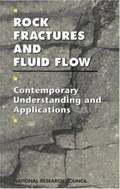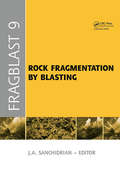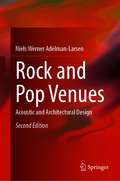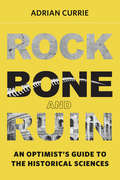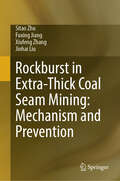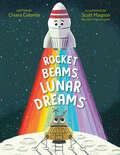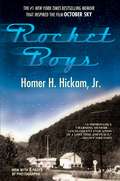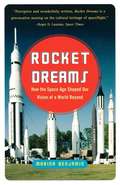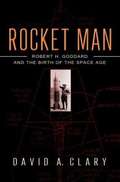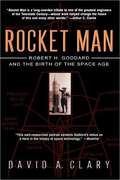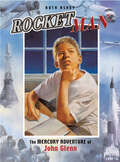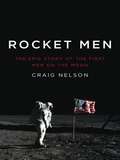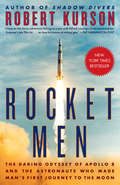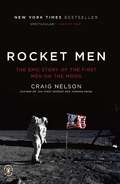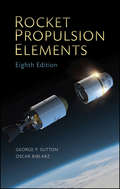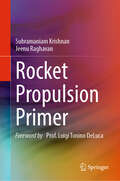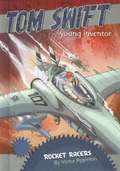- Table View
- List View
Rock Fractures And Fluid Flow: Contemporary Understanding and Applications
by Committee on Fracture Characterization Fluid FlowScientific understanding of fluid flow in rock fractures--a process underlying contemporary earth science problems from the search for petroleum to the controversy over nuclear waste storage--has grown significantly in the past 20 years. This volume presents a comprehensive report on the state of the field, with an interdisciplinary viewpoint, case studies of fracture sites, illustrations, conclusions, and research recommendations.The book addresses these questions: How can fractures that are significant hydraulic conductors be identified, located, and characterized? How do flow and transport occur in fracture systems? How can changes in fracture systems be predicted and controlled?Among other topics, the committee provides a geomechanical understanding of fracture formation, reviews methods for detecting subsurface fractures, and looks at the use of hydraulic and tracer tests to investigate fluid flow. The volume examines the state of conceptual and mathematical modeling, and it provides a useful framework for understanding the complexity of fracture changes that occur during fluid pumping and other engineering practices.With a practical and multidisciplinary outlook, this volume will be welcomed by geologists, petroleum geologists, geoengineers, geophysicists, hydrologists, researchers, educators and students in these fields, and public officials involved in geological projects.
Rock Fragmentation by Blasting: Proceedings of the 9th Int. Symp. on Rock Fragmentation by Blasting - Fragblast 9, Sept. 2009, Granada Spain
by José A. SanchidriánThis volume contains the papers presented at the 9th International Symposium on Rock Fragmentation by Blasting, held in Granada, Spain, 13-17 August 2009. A state-of-the-art collection of articles on developments in rock blasting and explosives engineering, with contributions on rock characterization, explosives and initiation systems, blast design and monitoring, fragmentation assessment, numerical modeling, vibrations from blasting, environmental and economical aspects of rock blasting, and more. Containing unique knowledge, case studies, ideas and insights, this volume is must-have literature for researchers and practitioners in the field of explosives and blasting.
Rock Legends
by Paul MurdinThis book relates the history ofasteroid discoveries and christenings, from those of the early pioneeringgiants of Hersehel and Piazzi to modern-day amateurs. Moving from history andanecdotal information to science, the book's structure is provided by the namesof the asteroids, including one named after the author. Free from a need to conform toscientific naming conventions, the names evidence hero-worship, sycophancy,avarice, vanity, whimsy, erudition and wit, revealing the human side ofastronomers, especially where controversy has followed the christening. Murdindraws from extensive historical records to explore the debate over these names. Each age reveals its own biases and preferences in the naming process. Originally regarded as "vermin ofthe skies," asteroids are minor planets, rocky scraps left over from theformation of the larger planets, or broken fragments of worlds that havecollided. Their scientific classification as "minor" planets makes them seemunimportant, but over the past decades asteroids have been acknowledged to bekey players in the Solar System. This view of their starring role even alters thetrajectories of spacecraft: NASA's policy for new space missions en route tothe outer planets is that they must divert to study passing asteroids wheneverpossible. This book provides for readers a complete tour of the fascinatingworld of asteroids.
Rock Secrets
by Betsy JamesEvery single rock has a secret story to tell about what the earth was like long ago.
Rock Star #1
by Vanessa Brantley-Newton Kelly Starling LyonsFans of Princess Posey and Ivy and Bean will enjoy engaging with science-loving Jada Jones in this easy-to-read chapter book.When Jada Jones's best friend moves away, school feels like the last place she wants to be. She'd much rather wander outside looking for cool rocks to add to her collection, since finding rocks is much easier than finding friends. So when Jada's teacher announces a class project on rocks and minerals, Jada finally feels like she's in her element. The only problem: one of her teammates doesn't seem to like any of Jada's ideas. She doesn't seem to like Jada all that much, either. Can Jada figure out a way to make a winning science project and a new friend? The early chapter book bridges between leveled readers and chapter books for fluent readers adjusting to the chapter book format. At about 5,000 words, with short chapters and two-color art on almost every page, it will appeal to this unique reader. The two-color art throughout will help readers transition from the familiar four-color art of leveled readers and ease them into black-and-white chapter books.
Rock and Pop Venues: Acoustic and Architectural Design
by Niels Werner Adelman-LarsenThis new edition of this standard work adds several new information the book, so that sound engineering and architects can better assess the acoustic value of a Rock and Pop Venue. In particular, new insights to the influence of sound absorbers in reflected and important ISO standards are included into the new edition. Based on the first ever scientific investigations on recommendable acoustics for amplified music conducted by the author, this book sets forward precise guidelines for acoustical engineers to optimize the acoustics in existing or future halls for amplified music. It Gives precise guidelines on how to design the acoustics in venues that present amplified music Debates essential construction details, including placement of sound system and use of possible building materials, in the architectural design of new venues or the renovation of old ones Portrays 75 well-known European Rock & Pop venues, their architecture and acoustic properties. 20 venues were rated for their acoustics by music professionals leading to an easy-to-use assessment methodology
Rock | Water | Life: Ecology and Humanities for a Decolonial South Africa
by Lesley GreenIn Rock | Water | Life Lesley Green examines the interwoven realities of inequality, racism, colonialism, and environmental destruction in South Africa, calling for environmental research and governance to transition to an ecopolitical approach that could address South Africa's history of racial oppression and environmental exploitation. Green analyzes conflicting accounts of nature in environmental sciences that claim neutrality amid ongoing struggles for land restitution and environmental justice. Offering in-depth studies of environmental conflict in contemporary South Africa, Green addresses the history of contested water access in Cape Town; struggles over natural gas fracking in the Karoo; debates about decolonizing science; the potential for a politics of soil in the call for land restitution; urban baboon management; and the consequences of sending sewage to urban oceans.
Rock, Bone, and Ruin: An Optimist's Guide to the Historical Sciences (Life and Mind: Philosophical Issues in Biology and Psychology)
by Adrian CurrieAn argument that we should be optimistic about the capacity of “methodologically omnivorous” geologists, paleontologists, and archaeologists to uncover truths about the deep past. The “historical sciences”—geology, paleontology, and archaeology—have made extraordinary progress in advancing our understanding of the deep past. How has this been possible, given that the evidence they have to work with offers mere traces of the past? In Rock, Bone, and Ruin, Adrian Currie explains that these scientists are “methodological omnivores,” with a variety of strategies and techniques at their disposal, and that this gives us every reason to be optimistic about their capacity to uncover truths about prehistory. Creative and opportunistic paleontologists, for example, discovered and described a new species of prehistoric duck-billed platypus from a single fossilized tooth. Examining the complex reasoning processes of historical science, Currie also considers philosophical and scientific reflection on the relationship between past and present, the nature of evidence, contingency, and scientific progress.Currie draws on varied examples from across the historical sciences, from Mayan ritual sacrifice to giant Mesozoic fleas to Mars's mysterious watery past, to develop an account of the nature of, and resources available to, historical science. He presents two major case studies: the emerging explanation of sauropod size, and the “snowball earth” hypothesis that accounts for signs of glaciation in Neoproterozoic tropics. He develops the Ripple Model of Evidence to analyze “unlucky circumstances” in scientific investigation; examines and refutes arguments for pessimism about the capacity of the historical sciences, defending the role of analogy and arguing that simulations have an experiment-like function. Currie argues for a creative, open-ended approach, “empirically grounded” speculation.
Rockburst in Extra-Thick Coal Seam Mining: Mechanism and Prevention
by Sitao Zhu Fuxing Jiang Xiufeng Zhang Jinhai LiuThis book provides a detailed introduction to the mechanism of rockburst in extremely thick coal seam mining and explores the mechanical mechanism on why the critical depth of rockburst in extremely thick coal seam mining is significantly smaller than that in thin to thick coal seams, it also proposes targeted monitoring, warning, and treatment technologies. The prevention and control of coal mine rockburst is a global problem, attracting engineers and scientists from various disciplines such as mining, geology, geophysics, and civil engineering to conduct research. This book provides multiple case studies of rockburst accidents in mining of ultra-thick coal seams and provides a detailed analysis of the mechanisms and treatment technologies of each rockburst accident. It aims at graduate students, researchers, and on-site engineers who are interested in the mechanism of rockburst occurrence, monitoring, early warning, and treatment technology. The translation was done with the help of artificial intelligence. The present version has been revised technically and linguistically by the authors in collaboration with a professional translator.
Rocket Beams, Lunar Dreams
by Chiara ColombiThe follow-up to Rocket Ship, Solo Trip that is sure to delight fans of Goodnight, Goodnight, Construction Site and explores the complicated emotions around building friendships and overcoming disappointment; featuring art from New York Times bestselling illustrator Scott Magoon!"Rocket ship. Lunar trip.Such excitement on the strip.Launchpad's ready. Clouds, at bay.She's going to the moon today!"After embarking on her first solo mission to place a satellite into orbit, Rocket is back, and she&’s headed on a lunar expedition! But this time she&’s not going alone. Instead of exploring, Rocket&’s mission is to drop off the spacecraft, Lander, and then return to Earth while Lander investigates the Moon's surface.Rocket can&’t seem to muster up any friendly words on their journey into orbit—the Moon is big! Why can&’t they share?! But when she learns that Lander is afraid of heights and needs a helping hand, Rocket decides to put aside her disappointment and help Lander accomplish his goal.With delightful rhyming stanzas and pictures by New York Times bestselling illustrator Scott Magoon, Rocket Beams, Lunar Dreams explores the complicated emotions around overcoming fears, forging friendships, and making peace with the fact that things don't always turn out as expected.
Rocket Billionaires: Elon Musk, Jeff Bezos, and the New Space Race
by Tim FernholzThis &“smart analysis of the New Space sector&” goes inside the rapid rise and dramatic rivalry of private space companies SpaceX and Blue Origin (The New York Times Book Review). For the outsize personalities staking their fortunes on spaceships, the new race to explore space could be a dead end, a lucrative opportunity—or the key to humanity&’s survival. Rocket Billionaires shines a light on Elon Musk and Jeff Bezos as they attempt to make history, reinvent the space economy, and feed their own egos. Beyond these two towering figures, Tim Fernholz introduces a supporting cast of equally fascinating entrepreneurs, from the irrepressible British mogul Richard Branson to the satellite internet visionary Greg Wyler. Fernholz&’s fly‑on‑the‑wall reporting captures an industry in the midst of disruption. While NASA seeks to preserve its ambitious space program, traditional aerospace firms like Boeing and Lockheed Martin scramble to adapt to new competitors, lobbyists tussle over public funds, and lawmakers try to prevent this new space race from sparking global conflict. It&’s a high‑stakes marathon that Fernholz recounts with expert analysis and revealing detail. Featured on NPR and PBS&’s SciTech Now, and in Fast Company, Forbes, and the Wall Street Journal
Rocket Boys (Coalwood #1)
by Homer H. Hickam Jr.The #1 New York Times bestselling memoir that inspired the film October Sky, Rocket Boys is a uniquely American memoir—a powerful, luminous story of coming of age at the dawn of the 1960s, of a mother's love and a father's fears, of a group of young men who dreamed of launching rockets into outer space . . . and who made those dreams come true. <p><p> With the grace of a natural storyteller, NASA engineer Homer Hickam paints a warm, vivid portrait of the harsh West Virginia mining town of his youth, evoking a time of innocence and promise, when anything was possible, even in a company town that swallowed its men alive. A story of romance and loss, of growing up and getting out, Homer Hickam's lush, lyrical memoir is a chronicle of triumph—at once exquisitely written and marvelously entertaining.
Rocket Dreams: How the Space Age Shaped Our Vision of the World
by Marina BenjaminIn 1958, mankind's centuries-long flirtation with space flight became a torrid love affair. For a decade, tens of millions of people were enraptured -- first, by the U.S.-Soviet race to the moon, and finally, as America outstripped its rival, by Project Apollo alone. It is now more than three decades since the last man walked on the moon...more time than between the first moonwalk and the beginning of World War II. Apollo did not, as had been promised by a generation of visionaries, herald the beginning of the Space Age, but its end. Or did it? Project Apollo, like a cannonball, reached its apogee and returned to earth, but the trajectory of that return was complex. America's atmosphere -- its economic, scientific, and cultural atmosphere -- made for a very complicated reentry that produced many solutions to the trajectory problem. Rocket Dreams is about those solutions...about the places where the space program landed. In Rocket Dreams, an extraordinarily talented young writer named Marina Benjamin will take you on a journey to those landing sites. A visit with retired astronauts at a celebrity autograph show is a starting point down the divergent paths taken by the pioneers, including Edgar Mitchell, founder of the "church" of Noëtic Sciences. Roswell, New Mexico is a landing site of a different order, the "magnetic north" of UFO belief in the United States -- a belief that began its most dramatic growth precisely at the time that the path of the space program began its descent. In the vernacular, the third law of motion states that what goes up, must come down. Thus the tremendous motive force that energized the space program didn't just vanish; it was conserved and transformed, making bestsellers out of fantasy literature, spawning Gaia, and giving symbolism to the environmental movement. Everything from the pop cultural boom in ufology to the worldwide Search for Extra-Terrestrial Intelligence (SETI) feeds on the energy given off by America's leap toward space. Rocket Dreams is an eloquent tour of this Apollo-scarred landscape. It is also an introduction to some of the most fascinating characters imaginable: Some long dead, like the crackpot visionary Alfred Lawson, who saw in space flight a new stage of human evolution ("Alti-Man"), or Robert Goddard, the father of rocketry, whose workshop in Roswell stands only half a mile from shops selling posters of alien visitors. Others are very much alive -- like Stewart Brand, creator of the Whole Earth Catalog and partner with Gerard O'Neill in the drive to build free-floating space colonies, and SETI astronomer Seth Shostak, who has spent decades listening to the skies, hoping for the first contact with another intelligent species. Perceptive, original, and wonderfully written, informed by history, science, and an acute knowledge of popular culture, Rocket Dreams is a brilliant book by a remarkable talent.
Rocket Girl
by George D. Morgan Ashley StroupeThis is the extraordinary true story of America's first female rocket scientist, told by her son. It describes Mary Sherman Morgan's crucial contribution to launching America's first satellite and the author's labyrinthine journey to uncover his mother's lost legacy - a legacy buried deep under a lifetime of secrets political, technological, and personal. Blending a fascinating personal history with dramatic historical events taking place on the world stage, this compelling narrative brings long-overdue attention to a modest but brilliant woman whose work proved essential for America's early space program. In 1938, a young German rocket enthusiast named Wernher von Braun had dreams of building a rocket that could fly him to the moon. On the opposite side of the world, a young farm girl named Mary Sherman was attending high school in Ray, North Dakota. In an age when girls rarely dreamed of a career in science, Mary wanted to be a chemist. A decade later the dreams of these two disparate individuals would coalesce in ways neither could have imagined. In a vivid narrative, Morgan relates how World War II and the Cold War space race with the Russians changed the fates of both von Braun and his mother. When von Braun and other top engineers could not find a solution to the repeated failures that plagued the nascent US rocket program, North American Aviation, where Mary Sherman Morgan then worked, was given the challenge. Recognizing her talent for chemistry, company management turned the assignment over to young Mary. In the end, America succeeded in launching rockets into space, but only because of the joint efforts of the brilliant farm girl from North Dakota and the famous German scientist. While von Braun went on to become a high-profile figure in NASA's manned space flight, Mary Sherman Morgan and her contributions fell into obscurity.
Rocket Girl
by George D. MorganAN UNSUNG HEROINE OF THE SPACE AGE--HER STORY FINALLY TOLD. This is the extraordinary true story of America's first female rocket scientist. Told by her son, it describes Mary Sherman Morgan's crucial contribution to launching America's first satellite and the author's labyrinthine journey to uncover his mother's lost legacy--one buried deep under a lifetime of secrets political, technological, and personal. In 1938, a young German rocket enthusiast named Wernher von Braun had dreams of building a rocket that could fly him to the moon. In Ray, North Dakota, a young farm girl named Mary Sherman was attending high school. In an age when girls rarely dreamed of a career in science, Mary wanted to be a chemist. A decade later the dreams of these two disparate individuals would coalesce in ways neither could have imagined. World War II and the Cold War space race with the Russians changed the fates of both von Braun and Mary Sherman Morgan. When von Braun and other top engineers could not find a solution to the repeated failures that plagued the nascent US rocket program, North American Aviation, where Sherman Morgan then worked, was given the challenge. Recognizing her talent for chemistry, company management turned the assignment over to young Mary. In the end, America succeeded in launching rockets into space, but only because of the joint efforts of the brilliant farm girl from North Dakota and the famous German scientist. While von Braun went on to become a high-profile figure in NASA's manned space flight, Mary Sherman Morgan and her contributions fell into obscurity--until now. From the Trade Paperback edition.
Rocket Man: Robert H. Goddard and the Birth of the Space Age
by David A. ClaryThis is the definitive biography of Robert H. Goddard (1882-1945) who was the father of rocketry and space flight, launching the world's first liquid-fuel rockets and the first powered vehicles to break the sound barrier.
Rocket Man: Robert H. Goddard and the Birth of the Space Age
by David A. ClaryMore famous in his day than Einstein or Edison, the troubled, solitary genius Robert H. Goddard (1882-1945) was the American father of rocketry and space flight, launching the world's first liquid-fuel rockets and the first powered vehicles to break the sound barrier. Supported by Charles Lindbergh and Harry Guggenheim, through fiery, often explosive, experiments at Roswell, New Mexico, he invented the methods that carried men to the moon. Today, no rocket or jet plane can fly without using his inventions. Yet he is the "forgotten man" of the space age. His own government ignored his rocketry until the Germans demonstrated its principles in the V-2 missiles of World War II. The American government usurped his 214 patents, while suppressing his contributions in the name of national security, until it was forced to pay one million dollars for patent infringement. Goddard became famous again, monuments and medals raining upon his memory. But his renewed fame soon faded, and Goddard's pivotal role in launching the Space Age has been largely forgotten.
Rocket Man: The Mercury Adventure of John Glenn
by Ruth AshbyOn February 20, 1962, as millions of Americans waited anxiously, astronaut John Glenn blasted off in his rocket ship, Friendship 7, and became the first American to orbit the Earth.Although the risks of such a mission for Friendship 7 were well known, no one including Glenn knew the peril he was about to encounter in space. John Glenn was one of the Mercury 7 astronauts, the early pioneers of manned space flight. His historic flight followed years of intensive physical training and a devotion to a career in the exciting but risk-filled world of aviation.Ruth Ashby's dramatic story of John Glenn's near-disastrous mission in Friendship 7 also takes young readers through his small-town Ohio childhood, his extraordinary experiences as a fighter pilot in two wars, and his life as an astronaut in the prestigious and dangerous Mercury 7 program. The book concludes with Glenn's successful career as a US senator and his triumphant return to space in 1998 at the age of 77.
Rocket Men
by Craig NelsonOn 20 July 1969, man set foot on the moon. Motivated by politics, faith, science and wonder, the Apollo 11 mission was the greatest technical achievement of all time. It was the culmination of over a decade's worth of money and effort from more than 400,000 staff and crew. Rocket Men follows the astounding story of the lunar project, beginning at its inception at the start of the Cold War and tracing it through to its finest hour with the first moon landing and the astronauts' safe return. Through extensive interviews with astronauts, NASA staff and their families and never-before published documents, Craig Nelson presents an awe-inspiring human account of the voyage that changed the course of history. He takes us behind the scenes at Mission Control to describe every detail of the mission, from the astronauts' moon excursion suits, which had five hundred parts and weighed no less than fifty pounds, to terrifying revelations, such as how Armstrong and Aldrin could have been left stranded on the moon when a vital switch snapped on the landing craft. Rocket Men is the inside story of one of the most perilous and rewarding undertakings in history.
Rocket Men: The Daring Odyssey of Apollo 8 and the Astronauts Who Made Man's First Journey to the Moon
by Robert Kurson<p>By August 1968, the American space program was in danger of failing in its two most important objectives: to land a man on the Moon by President Kennedy’s end-of-decade deadline, and to triumph over the Soviets in space. With its back against the wall, NASA made an almost unimaginable leap: It would scrap its usual methodical approach and risk everything on a sudden launch, sending the first men in history to the Moon—in just four months. And it would all happen at Christmas. <p>In a year of historic violence and discord—the Tet Offensive, the assassinations of Martin Luther King, Jr., and Robert Kennedy, the riots at the Democratic National Convention in Chicago—the Apollo 8 mission would be the boldest, riskiest test of America’s greatness under pressure. In this gripping insider account, Robert Kurson puts the focus on the three astronauts and their families: the commander, Frank Borman, a conflicted man on his final mission; idealistic Jim Lovell, who’d dreamed since boyhood of riding a rocket to the Moon; and Bill Anders, a young nuclear engineer and hotshot fighter pilot making his first space flight. <p>Drawn from hundreds of hours of one-on-one interviews with the astronauts, their loved ones, NASA personnel, and myriad experts, and filled with vivid and unforgettable detail, <i>Rocket Men</i> is the definitive account of one of America’s finest hours. In this real-life thriller, Kurson reveals the epic dangers involved, and the singular bravery it took, for mankind to leave Earth for the first time—and arrive at a new world.</p>
Rocket Men: The Epic Story of the First Men on the Moon
by Craig NelsonRestoring the Drama, Majesty, and Sheer Improbability of an American Triumph that has now come to be taken for granted, this is the complete, definitive, and thrilling story of one of the greatest achievements of humankind. Through interviews, 23,000 pages of NASA oral histories, and declassified CIA documents on the space race, Rocket Men presents a grippingly vivid narrative of the mission to the moon that re-creates moments from the quotidian to the scientific to the magical, and takes you on that magnificent twentieth-century pilgrimage, a voyage into the unknown motivated by politics, faith, science, and wonder that changed the course of history.
Rocket Propulsion Elements
by Oscar Biblarz George P. SuttonThe definitive text on rocket propulsion--now revised to reflect advancements in the fieldFor sixty years, Sutton's Rocket Propulsion Elements has been regarded as the single most authoritative sourcebook on rocket propulsion technology. As with the previous edition, coauthored with Oscar Biblarz, the Eighth Edition of Rocket Propulsion Elements offers a thorough introduction to basic principles of rocket propulsion for guided missiles, space flight, or satellite flight. It describes the physical mechanisms and designs for various types of rockets' and provides an understanding of how rocket propulsion is applied to flying vehicles.Updated and strengthened throughout, the Eighth Edition explores:The fundamentals of rocket propulsion, its essential technologies, and its key design rationaleThe various types of rocket propulsion systems, physical phenomena, and essential relationshipsThe latest advances in the field such as changes in materials, systems design, propellants, applications, and manufacturing technologies, with a separate new chapter devoted to turbopumpsLiquid propellant rocket engines and solid propellant rocket motors, the two most prevalent of the rocket propulsion systems, with in-depth consideration of advances in hybrid rockets and electrical space propulsionComprehensive and coherently organized, this seminal text guides readers evenhandedly through the complex factors that shape rocket propulsion, with both theory and practical design considerations. Professional engineers in the aerospace and defense industries as well as students in mechanical and aerospace engineering will find this updated classic indispensable for its scope of coverage and utility.
Rocket Propulsion Primer
by Subramaniam Krishnan Jeenu RaghavanThis textbook covers fundamentals of rocket propulsion such as history, classification, qualitative design, quantitative design of internal ballistics and rocket vehicle optimization. It is intended to be used as a textbook by the undergraduate/advanced undergraduate students of aerospace engineering. It further describes the classification of aerospace propulsion, two-phase flows, nozzle contour design, advanced nozzle concepts (plug and expansion deflection nozzles) and materials. It also deals with the optimization of multistage rocket vehicles and their trajectories with reference to the currently operational orbital launch vehicles. This textbook contains numerous end-of-chapter problems to aid in self-learning of the students. It will be highly useful for the aerospace and mechanical engineering students. This can also be used as a reference guide by the scientists and engineers working in the areas of aerospace engineering.
Rocket Racers (Tom Swift Young Inventor #4)
by Victor AppletonCAN TOM AVOID A ROCKET WRECKAGE DISASTER? Tom Swift isn't your average teenager--he's a science prodigy! And, his inventions always involve cutting edge technology. With the help of his best friends Bud and Yo, Tom tests his gadgets and runs into all sorts of adventures. From deep-sea diving and shark bites to outsmarting an antiscience terrorist group, Tom Swift, Young Inventor, will keep you on the edge of your seat!
